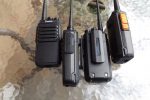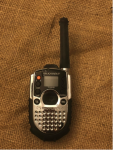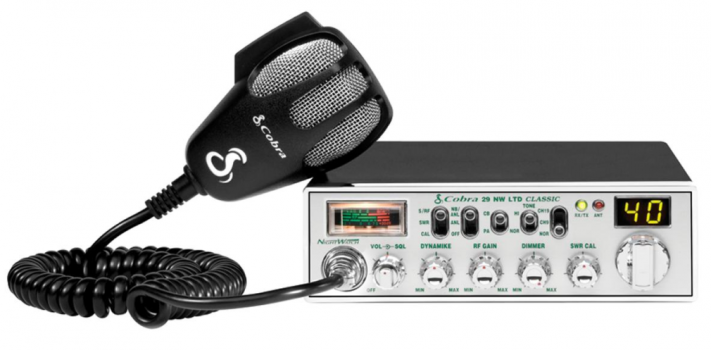(Continued from Part 1.)
Back to the matter of radio spectrum: It is regulated by the government, and it pretty much has to be. No matter how libertarian you lean and no matter how dim your view of government power, somebody has to regulate the spectrum, or it would be completely useless, with would-be users interfering with each other left and right. Every developed nation has a government agency that allocates radio spectrum to different uses, and in turn countries cooperate internationally via various treaties and agreements.
In the United States, this responsibility has been delegated by Congress to the Federal Communications Commission (FCC). Setting aside the Constitutionally dubious nature of such a delegation, that is the legal reality. The FCC hands out licenses for people that entitle them to use different parts of the radio spectrum for different purposes, such as broadcast radio and TV, public safety, mobile phones, military, etc. As a basic rule, you are not allowed to make any radio transmission without a license. There are a few slices of spectrum that are available for the public to use for personal communication, and I discuss those later in this article.
Obviously, if we suffer a complete breakdown of the rule of law, then much of this may go out the window (along with the National Firearms Act, for that matter). However, radio communication takes practice to be useful in an emergency, and it is much more likely you will need your radio gear in a situation that is short of a complete societal breakdown. As a result, it is helpful to know the rules, at least in broad strokes, and to have a plan for how to communicate within them.
A Word About Baofengs
 A few years ago, someone started importing cheap Chinese VHF/UHF radios designed for amateur radio use. There are various brands and models, but the most ubiquitous is the Baofeng UV5R. These were sold for amazingly low prices — as little as $20 each on Amazon. People, including many preppers, have bought them in droves. The problem is that most purchasers have no idea how to use the things. I have a couple of UV5Rs, and I have evaluated them. I was able to program them and get them to talk to a couple of local amateur radio repeaters. They seemed to work well enough, but the build quality seems dubious to me. Unlike most units made for amateur radio use, Baofengs will transmit outside the amateur bands out of the box with no modifications necessary.
A few years ago, someone started importing cheap Chinese VHF/UHF radios designed for amateur radio use. There are various brands and models, but the most ubiquitous is the Baofeng UV5R. These were sold for amazingly low prices — as little as $20 each on Amazon. People, including many preppers, have bought them in droves. The problem is that most purchasers have no idea how to use the things. I have a couple of UV5Rs, and I have evaluated them. I was able to program them and get them to talk to a couple of local amateur radio repeaters. They seemed to work well enough, but the build quality seems dubious to me. Unlike most units made for amateur radio use, Baofengs will transmit outside the amateur bands out of the box with no modifications necessary.
Baofengs are not intuitive to program or use if you are not used to tinkering with amateur radio gear. Rather than using the keypad and menu system built into the radio, many people program them using a laptop, a $10 programming cable, and free software downloaded from the Internet, which is admittedly easier. I need to be clear here: The only legal uses for a Baofeng are to either 1) receive and listen to signals, or 2) transmit on authorized amateur radio frequencies if you have an appropriate license. It is not legal to use them to transmit on FRS, GMRS, or MURS (these terms are defined in the following sections). You can of course listen to whatever you want, and for that purpose alone, a Baofeng is worth its price, but it is not a legal solution to most people’s radio needs.
I know a number of people who have purchased these radios and then put them in storage for future use without making any effort to learn how to use them. This is not a good plan. Unless you have a background in radio and specifically in tinkering with amateur radion handi-talkies (HTs), then you are likely to have a bit of a learning curve on your Baofengs. I personally don’t want to have to figure out my radio while I am trying to get out of Dodge.
Citizens Band (CB)
 Citizen band, or CB, was the original people’s radio service when solid-state electronics made transceivers widely available. It uses a slice of spectrum in the 11 meter range (specifically 26-27 MHz). The spectrum is channelized, meaning that the government has decided in advance to designate certain specific frequencies within the range as having channel numbers, and users are only allowed to transmit on those specific channels. The frequencies for the various channels are spaced out enough that they don’t interfere with each other. There are 40 defined CB channels, and channel 9 is reserved by FCC rule for emergency use. See the applicable rule in the Code of Federal Regulations (CFR) at 47 CFR 95.963, 95.931 (a)(2). The frequencies for the channels are as follows:
Citizen band, or CB, was the original people’s radio service when solid-state electronics made transceivers widely available. It uses a slice of spectrum in the 11 meter range (specifically 26-27 MHz). The spectrum is channelized, meaning that the government has decided in advance to designate certain specific frequencies within the range as having channel numbers, and users are only allowed to transmit on those specific channels. The frequencies for the various channels are spaced out enough that they don’t interfere with each other. There are 40 defined CB channels, and channel 9 is reserved by FCC rule for emergency use. See the applicable rule in the Code of Federal Regulations (CFR) at 47 CFR 95.963, 95.931 (a)(2). The frequencies for the channels are as follows:
| Channel | Freq. | Channel | Freq | Channel | Freq. |
| 1 | 26.965 | 16 | 27.155 | 31 | 27.315 |
| 2 | 26.975 | 17 | 27.165 | 32 | 27.325 |
| 3 | 26.985 | 18 | 27.175 | 33 | 27.335 |
| 4 | 27.005 | 19 | 27.185 | 34 | 27.345 |
| 5 | 27.015 | 20 | 27.205 | 35 | 27.355 |
| 6 | 27.025 | 21 | 27.215 | 36 | 27.365 |
| 7 | 27.035 | 22 | 27.225 | 37 | 27.375 |
| 8 | 27.055 | 23 | 27.255 | 38 | 27.385 |
| 9 | 27.065 | 24 | 27.235 | 39 | 27.395 |
| 10 | 27.075 | 25 | 27.245 | 40 | 27.405 |
| 11 | 27.085 | 26 | 27.265 | ||
| 12 | 27.105 | 27 | 27.275 | ||
| 13 | 27.115 | 28 | 27.285 | ||
| 14 | 27.125 | 29 | 27.295 | ||
| 15 | 27.135 | 30 | 27.305 |
CB uses amplitude modulation, or AM, to encode information on the radio waves. AM consumes less spectrum per channel than frequency modulation (FM), but it tends to be less clear and harder to understand. AM also tends to work better over longer distances. By law, CB users are also limited to 4 watts of power when making AM transmissions. 47 CFR 95.967. Up to 12 watts is legal when operating single side band transmissions (SSB). SSB is a useful operating mode that allows communications to be made using much less bandwidth. SSB is very popular with ham radio operators. It requires much more sophisticated equipment, and most CB transmitters are not SSB capable.
CB transmitters are required to be certified by the FCC, 47 CFR 95.61, and it is illegal to modify one. It is expressly illegal to use a transmitter intended for amateur radio use for CB communication. 47 CFR 95.935.
With the right antenna, 4 watts can theoretically allow you to communicate a long way on 11 meters. However, the CB service has been rendered almost unusable in many areas by users who run illegal power amplifiers, often putting out hundreds of watts of power through poorly-designed antennas. It is expressly illegal to run an external power amplifier on a CB radio, per 47 CFR 95.939. The FCC is fairly serious about enforcing this, but it is flouted by many. Once popular, CB has been relegated mostly to long-haul truckers, logging trucks, and off-road clubs at this point.
I do think that CB can be useful in some contexts, such as communicating between locations that are a few miles apart, but the keys are proper antenna design and placement and topography. 11 meter signals can in theory bounce off the ionosphere and allow the user to communicate over long distances, but at legal power levels this is unlikely to be consistent enough for reliable communications.
Family Radio Service (FRS)
 With CB having become largely unusable, the FCC introduced the Family Radio Service or FRS as an unlicensed service for personal, short-range communications. The FCC defines it as “[a] short-distance two-way voice communication service, with limited data applications, between low power hand-held radios, for facilitating individual, family, group, recreational and business activities.” 47 CFR 95.503. FRS uses spectrum in the UHF range (specifically 462-467 MHz), and it is also channelized. There are 22 defined channels. No matter what it says on the box, these are for short range use. FRS radios are limited in power. They are allowed 0.5 watts of power on channels 8-14 and 2 watts of power on channels 1-7 and channels 15-22. 47 CFR 95.567.
With CB having become largely unusable, the FCC introduced the Family Radio Service or FRS as an unlicensed service for personal, short-range communications. The FCC defines it as “[a] short-distance two-way voice communication service, with limited data applications, between low power hand-held radios, for facilitating individual, family, group, recreational and business activities.” 47 CFR 95.503. FRS uses spectrum in the UHF range (specifically 462-467 MHz), and it is also channelized. There are 22 defined channels. No matter what it says on the box, these are for short range use. FRS radios are limited in power. They are allowed 0.5 watts of power on channels 8-14 and 2 watts of power on channels 1-7 and channels 15-22. 47 CFR 95.567.
FRS radios can only be used with the built-in antenna, and there are limitations on the design of the antenna which limit the range of the radios. 47 CFR 95.587.
Users may only use FRS units as they are sold. These are FCC-certified, and they may not be modified. FRS is “licensed by rule,” so you don’t need an individual license to operate them. 47 CFR 95.305. Just buy the radios, and have at it. You are not required to transmit any station identification. 47 CFR 95.351. Here are the channels for those interested, as listed in 47 CFR sec. 95.563:
| Channel | Freq. | Channel | Freq. |
| 1 | 462.5625 | 12 | 467.6625 |
| 2 | 462.5875 | 13 | 467.6875 |
| 3 | 462.6125 | 14 | 467.7125 |
| 4 | 462.6375 | 15 | 462.55 |
| 5 | 462.6625 | 16 | 462.575 |
| 6 | 462.6875 | 17 | 462.6 |
| 7 | 462.7125 | 18 | 462.625 |
| 8 | 467.5625 | 19 | 462.65 |
| 9 | 467.5875 | 20 | 462.675 |
| 10 | 467.6125 | 21 | 462.7 |
| 11 | 467.6375 | 22 | 462.725 |
 Importantly, it is illegal to use modified amateur radio equipment for FRS (or GMRS, see the following section, in Part 3), per 47 CFR 95.335. You can only use transmitters that are FCC certified for FRS. There is, however, the overarching rule that an amateur radio station may always transmit on any frequency with whatever equipment it has, in an emergency. “No provision of these rules prevents the use by an amateur station of any means of radiocommunication at its disposal to provide essential communication needs in connection with the immediate safety of human life and immediate protection of property when normal communication systems are not available.” 47 CFR 97.403. So, in a true emergency, a licensed amateur radio operator could use his equipment to talk to users of FRS and GMRS radios if that is what was required to resolve the emergency.
Importantly, it is illegal to use modified amateur radio equipment for FRS (or GMRS, see the following section, in Part 3), per 47 CFR 95.335. You can only use transmitters that are FCC certified for FRS. There is, however, the overarching rule that an amateur radio station may always transmit on any frequency with whatever equipment it has, in an emergency. “No provision of these rules prevents the use by an amateur station of any means of radiocommunication at its disposal to provide essential communication needs in connection with the immediate safety of human life and immediate protection of property when normal communication systems are not available.” 47 CFR 97.403. So, in a true emergency, a licensed amateur radio operator could use his equipment to talk to users of FRS and GMRS radios if that is what was required to resolve the emergency.
FRS radios work fine for very short-range communications like taking the family to an amusement park or communication between vehicles on a road trip. I have had mixed success using them to talk to a hunting partner, depending on the distance between us and the terrain.
FRS radios can legally communicate with GMRS units. They use most of the same channels. 47 CFR 95.531(c). You used to be able to buy combination FRS/GMRS radios, but the sale of such unit is now prohibited. 47 CFR 95.591
I have owned a number of FRS radios over the years, mostly made by Motorol along with a pair of Midland units. They all worked fine for what they were. They are clearly consumer grade, and I would not trust any of them to hold up under adverse conditions. That said, they are inexpensive and easy to use for most people.
(To be continued tomorrow, in Part 3.)










